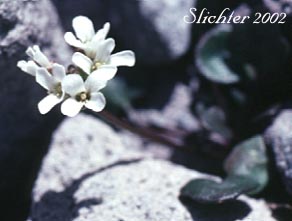

Alpine bittercress is an herbaceous annual with glabrous herbage. Plants arise from a taproot with several slender, often prostrate stems arising from 2-10 cm long. The numerous leaves are mostly basal with either entire blades, or with 2-4 shot, rounded teeth below the large leaflet at the tip. The petioles are 2-4 times longer than the blades and are slender. The basal leaves measure from 5-30 mm long. The 1-3 leaves on the stem are much reduced in size.
The inflorescence is a few-flowered raceme of white, four-petaled flowers. The flower stems are rising and measure from 4-10 mm long. The sepals measure from 1.5-2 mm long. Each petal measures from 3-5 mm long. The fruits are erect siliques from 1.5-3.5 cm long and 1-1.5 mm wide.
Variety pachyphylla: has leaves measuring from 10-30 mm long which are thick in cross-section. The leaves often have basal shallow lobes. The flower stems measure from 4-10 cm tall.
Variety bellidifolia: has leaves measuring from 5-15 mm long which are thin in cross-section. The leaf margins are entire. The flowering stems measure from 2-7 cm tall.
Alpine bittercress is often found in moist, rocky subalpine to alpine areas, and is often found on north-facing openings beneath rocks or scree.
Alpine bittercress may be found from the Arctic south through Alaska and Canada to northern California, Alberta, and New Hampshire.
Variety pachyphylla may be found in the Cascades of Oregon south into northern California.
Variety bellidifolia may be found across the Arctic and south to the Cascades of Washington and eastward across Canada to the northeastern United States.